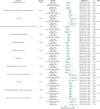Genetically predicted serum metabolites mediate the association between inflammatory proteins and polycystic ovary syndrome: a Mendelian randomization study
- PMID: 39691364
- PMCID: PMC11649973
- DOI: 10.3389/fmed.2024.1433612
Genetically predicted serum metabolites mediate the association between inflammatory proteins and polycystic ovary syndrome: a Mendelian randomization study
Abstract
Objective: To investigate the association between polycystic ovary syndrome (PCOS) and inflammatory proteins, and to identify and quantify the role of serum metabolites as potential mediators.
Methods: Utilizing summary-level data from a genome-wide association study (GWAS), we conducted a two-sample Mendelian Randomization (MR) analysis, a genetic approach that uses genetic variants as instrumental variables to assess the causal relationships between risk factors and outcomes. This analysis involved genetically predicted PCOS (1,639 cases and 218,970 controls) and inflammatory proteins (14,824 participants of primarily European descent). Additionally, a two-step MR analysis was performed to quantify the proportion of the effect of serum metabolites-mediated inflammatory proteins on PCOS. The Inverse Variance Weighted (IVW) method, a statistical technique used within MR to combine data from multiple genetic variants, was used to estimate the causal effects.
Results: The IVW method revealed that the inflammatory proteins IFN-γ (p-value = 0.037, OR = 1.396, 95% CI = 1.020-1.910) and CCL7 (p-value = 0.033, OR = 1.294, 95% CI = 1.021-1.641) were associated with an increased risk of PCOS, while IL-6 (p-value = 0.015, OR = 0.678, 95% CI = 0.495-0.929) and MMP-10 (p-value = 0.025, OR = 0.753, 95% CI = 0.587-0.967) were associated with a decreased risk. No significant evidence suggested an effect of genetically predicted PCOS on inflammatory proteins. The serum metabolite X-11444 was found to mediate 5.44% (95% CI: 10.8-0.0383%) of the effect of MMP-10 on PCOS.
Conclusion: This study not only introduces novel causal associations between inflammatory proteins and PCOS but also highlights the mediating role of serum metabolites in these associations. By applying MR, we were able to minimize confounding and reverse causality, offering robust insights into the biological mechanisms underlying PCOS. These findings advance the understanding of PCOS pathogenesis, particularly in relation to inflammatory pathways and serum metabolite interactions, and suggest potential therapeutic targets that could inform future clinical interventions aimed at mitigating inflammation-related PCOS risks.
Keywords: Chemokine C-C Motif Ligand 7; Interferon gamma; Interleukin-6; Matrix metalloproteinase-10; Mendelian randomization; inflammatory proteins; polycystic ovary syndrome; serum metabolites.
Copyright © 2024 Jia, Zhou, Liu and Li.
Conflict of interest statement
The authors declare that the research was conducted in the absence of any commercial or financial relationships that could be construed as a potential conflict of interest.
Figures




Similar articles
-
Causal Effects of Genetically Determined Metabolites on Risk of Polycystic Ovary Syndrome: A Mendelian Randomization Study.Front Endocrinol (Lausanne). 2020 Sep 8;11:621. doi: 10.3389/fendo.2020.00621. eCollection 2020. Front Endocrinol (Lausanne). 2020. PMID: 33013699 Free PMC article.
-
Causal relationship between inflammatory cytokines and polycystic ovary syndrome: a bidirectional mendelian randomization study.J Ovarian Res. 2024 Nov 5;17(1):217. doi: 10.1186/s13048-024-01525-x. J Ovarian Res. 2024. PMID: 39501339 Free PMC article.
-
Investigating the metabolomic pathways in female reproductive endocrine disorders: a Mendelian randomization study.Front Endocrinol (Lausanne). 2024 Oct 31;15:1438079. doi: 10.3389/fendo.2024.1438079. eCollection 2024. Front Endocrinol (Lausanne). 2024. PMID: 39544240 Free PMC article.
-
Causal relationship between gut microbiota and polycystic ovary syndrome: a literature review and Mendelian randomization study.Front Endocrinol (Lausanne). 2024 Feb 1;15:1280983. doi: 10.3389/fendo.2024.1280983. eCollection 2024. Front Endocrinol (Lausanne). 2024. PMID: 38362275 Free PMC article. Review.
-
Childhood, adolescent, and adulthood adiposity are associated with risk of PCOS: a Mendelian randomization study with meta-analysis.Hum Reprod. 2023 Jun 1;38(6):1168-1182. doi: 10.1093/humrep/dead053. Hum Reprod. 2023. PMID: 37015099 Free PMC article.
References
-
- Dey R, Bhattacharya K, Basak AK, Paul N, Bandyopadhyay R, Ray Chaudhuri G, et al. . Inflammatory perspectives of polycystic ovary syndrome: role of specific mediators and markers. Middle East Fertil Soc J. (2023) 28:33. doi: 10.1186/s43043-023-00158-2 - DOI
LinkOut - more resources
Full Text Sources

